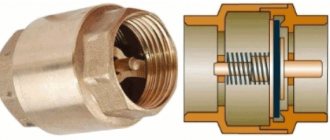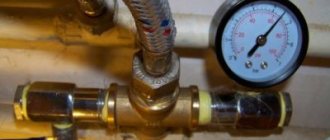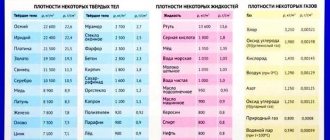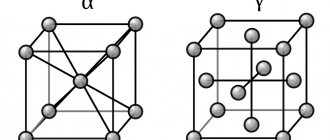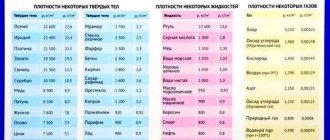How much does 1 liter of ice weigh?
How much does 1 liter of ice weigh? Ice is a solid state of aggregation of water - 1 liter weighs 917 g (0.917 kg).
Interesting materials:
How many liters are in a standard enamel bucket? How many horses are there in Java 250? How many peas per 2 liters of soup? How many stores does the Bristol chain have? How many magnets are there in a hard drive? What is the maximum score in Russian? How much semolina for 0.5 liters? How much oil should there be in an oil heater? How much oil should I pour into the Moskvich 412 bridge? How many continents and oceans are there on our planet?
Specific gravity of water, basic concepts and principles of hydrostatics
Specific gravity of water The most important physical properties of water are its viscosity, density, specific gravity , and compressibility.
The viscosity of water is its ability to resist shear forces. Due to the fact that water has mobility, its particles and layers can move sliding relative to each other. In this case, internal friction forces arise between the layers of liquid, preventing movement. These forces cause the appearance of viscosity.
The viscosity of water is low. When the water temperature increases from 20 to 30°, its viscosity decreases by approximately 20%.
The density of water is its mass per unit volume. Density is denoted by the Greek letter p and in the international SI system it is measured in kilograms per cubic meter (kg/m3): p = M: V
where M is the mass of the liquid, kg; V is the volume of liquid, m3.
The density of fresh water at 4° is 1000 kg/m3. The density of salty sea water is 1010-1030 kg/m3. The density of air, for example, is 1.29 kg/m3 and is almost 800 times less than the density of water. Its specific gravity depends on the density of water.
The specific gravity of water is the weight per unit volume. It is denoted by the Greek letter y and measured in the technical system of units MKGSS in kilogram-force per cubic meter (kg/m3): y = G: V
where G is the weight (gravity) of water, kg.
In the international SI system, the unit of specific gravity of a liquid is newton per cubic meter (N/m3). 1 n = 0.102 kg.
The density and specific gravity of water vary little depending on pressure and temperature. The specific gravity of fresh water is almost equal to 1000 kg/m3, or 9815 m/m3. Knowing the specific gravity of water allows us to judge a person’s buoyancy.
The compressibility of water is its property of decreasing in volume as pressure increases. The compressibility of water is extremely insignificant, but as a result of compression, hydrostatic pressure forces arise in it. Under normal conditions, a fluid at rest is compressed under the influence of gravity (its own weight of the fluid and atmospheric pressure).
The force of hydrostatic pressure acts on any surface of a body immersed in water. The ear pain experienced by a swimmer who has dived to great depths is caused by the forces of hydrostatic pressure of water on the eardrum. Water pressure forces are directed perpendicular to the surface of the body on which they act.
A few more similar articles from our website:
Butterfly swimming technique. General coordination of movements of the arms, legs, torso and breathing. Part 2
Turns. Open turns.
Swimming.Principles of learning and training.Strength.
You have refueled, but are not sure if it is a winter diesel fuel
To find out the truth, pour diesel fuel into a 3-liter jar and leave it overnight in an apartment where the room temperature is 18 - 20 degrees. In the morning, measure the density of diesel fuel using a hydrometer. Indicators must comply with GOST.
It is necessary to take into account that the density itself indicates that diesel fuel is not summer fuel, but you will not know what quality it is.
There are also special methods and comparative tables that allow you to quickly find out the density of diesel fuel at different temperatures using special graphs.
Now there are even online services on the Internet that allow you to quickly find out the density of diesel fuel. But you can’t take the online service with you on the road.
Links[edit]
- National Council of Design and Survey Examiners (2005). Fundamentals of Engineering Supplied - Handbook
(7th ed.). ISBN 1-932613-00-5. - ^ B s d e e Finnemore, J. E. (2002). Fluid Mechanics with Engineering Applications
. New York: McGraw-Hill. ISBN 0-07-243202-0. - Das, Braja M. (2007). Principles of Geotechnical Engineering
. Canada: Chris Carson. ISBN 0-495-07316-4. - Transtech Group, Inc. (2012). Basic definitions and terminology of soils
. https://www.intelligentcompaction.com/downloads/IC_RelatedDocs/SoilCmpct_Basic%20definitions%20of%20Soils.pdf (page accessed December 7, 2012
Table of thermal conductivity of thermal insulation materials
To make it easier to keep your house warm in winter and cool in summer, the thermal conductivity of walls, floors and roofs must be at least a certain figure, which is calculated for each region. The composition of the “pie” of walls, floor and ceiling, the thickness of the materials are taken into account so that the total figure is no less (or better yet, at least a little more) recommended for your region.
Heat transfer coefficient of modern building materials for enclosing structures
When choosing materials, it is necessary to take into account that some of them (not all) conduct heat much better in conditions of high humidity. If such a situation may occur for a long period of time during operation, the thermal conductivity for this condition is used in the calculations. The thermal conductivity coefficients of the main materials used for insulation are given in the table.
| Name of material | Thermal conductivity coefficient W/(m °C) | ||
| Dry | At normal humidity | At high humidity | |
| Woolen felt | 0,036-0,041 | 0,038-0,044 | 0,044-0,050 |
| Stone mineral wool 25-50 kg/m3 | 0,036 | 0,042 | 0,,045 |
| Stone mineral wool 40-60 kg/m3 | 0,035 | 0,041 | 0,044 |
| Stone mineral wool 80-125 kg/m3 | 0,036 | 0,042 | 0,045 |
| Stone mineral wool 140-175 kg/m3 | 0,037 | 0,043 | 0,0456 |
| Stone mineral wool 180 kg/m3 | 0,038 | 0,045 | 0,048 |
| Glass wool 15 kg/m3 | 0,046 | 0,049 | 0,055 |
| Glass wool 17 kg/m3 | 0,044 | 0,047 | 0,053 |
| Glass wool 20 kg/m3 | 0,04 | 0,043 | 0,048 |
| Glass wool 30 kg/m3 | 0,04 | 0,042 | 0,046 |
| Glass wool 35 kg/m3 | 0,039 | 0,041 | 0,046 |
| Glass wool 45 kg/m3 | 0,039 | 0,041 | 0,045 |
| Glass wool 60 kg/m3 | 0,038 | 0,040 | 0,045 |
| Glass wool 75 kg/m3 | 0,04 | 0,042 | 0,047 |
| Glass wool 85 kg/m3 | 0,044 | 0,046 | 0,050 |
| Expanded polystyrene (foam plastic, EPS) | 0,036-0,041 | 0,038-0,044 | 0,044-0,050 |
| Extruded polystyrene foam (EPS, XPS) | 0,029 | 0,030 | 0,031 |
| Foam concrete, aerated concrete with cement mortar, 600 kg/m3 | 0,14 | 0,22 | 0,26 |
| Foam concrete, aerated concrete with cement mortar, 400 kg/m3 | 0,11 | 0,14 | 0,15 |
| Foam concrete, aerated concrete with lime mortar, 600 kg/m3 | 0,15 | 0,28 | 0,34 |
| Foam concrete, aerated concrete with lime mortar, 400 kg/m3 | 0,13 | 0,22 | 0,28 |
| Foam glass, crumbs, 100 - 150 kg/m3 | 0,043-0,06 | ||
| Foam glass, crumbs, 151 - 200 kg/m3 | 0,06-0,063 | ||
| Foam glass, crumbs, 201 - 250 kg/m3 | 0,066-0,073 | ||
| Foam glass, crumbs, 251 - 400 kg/m3 | 0,085-0,1 | ||
| Foam block 100 - 120 kg/m3 | 0,043-0,045 | ||
| Foam block 121-170 kg/m3 | 0,05-0,062 | ||
| Foam block 171 - 220 kg/m3 | 0,057-0,063 | ||
| Foam block 221 - 270 kg/m3 | 0,073 | ||
| Ecowool | 0,037-0,042 | ||
| Polyurethane foam (PPU) 40 kg/m3 | 0,029 | 0,031 | 0,05 |
| Polyurethane foam (PPU) 60 kg/m3 | 0,035 | 0,036 | 0,041 |
| Polyurethane foam (PPU) 80 kg/m3 | 0,041 | 0,042 | 0,04 |
| Cross-linked polyethylene foam | 0,031-0,038 | ||
| Vacuum | |||
| Air +27°C. 1 atm | 0,026 | ||
| Xenon | 0,0057 | ||
| Argon | 0,0177 | ||
| Airgel (Aspen aerogels) | 0,014-0,021 | ||
| Slag | 0,05 | ||
| Vermiculite | 0,064-0,074 | ||
| Foam rubber | 0,033 | ||
| Cork sheets 220 kg/m3 | 0,035 | ||
| Cork sheets 260 kg/m3 | 0,05 | ||
| Basalt mats, canvases | 0,03-0,04 | ||
| Tow | 0,05 | ||
| Perlite, 200 kg/m3 | 0,05 | ||
| Expanded perlite, 100 kg/m3 | 0,06 | ||
| Linen insulating boards, 250 kg/m3 | 0,054 | ||
| Polystyrene concrete, 150-500 kg/m3 | 0,052-0,145 | ||
| Granulated cork, 45 kg/m3 | 0,038 | ||
| Mineral cork on a bitumen basis, 270-350 kg/m3 | 0,076-0,096 | ||
| Cork flooring, 540 kg/m3 | 0,078 | ||
| Technical cork, 50 kg/m3 | 0,037 |
Some of the information is taken from standards that prescribe the characteristics of certain materials (SNiP 23-02-2003, SP 50.13330.2012, SNiP II-3-79* (Appendix 2)). Those materials that are not specified in the standards are found on the manufacturers’ websites
Since there are no standards, they can differ significantly from different manufacturers, so when purchasing, pay attention to the characteristics of each material purchased
Table of water density (depending on temperature)
The water density values in the table refer to fresh or distilled water. If we consider sea water, salt water or water with impurities, then its density will be higher.
| Temperature, C | Density, kg/m3 |
| 999.87 | |
| 2 | 999.97 |
| 4 | 1000 |
| 6 | 999.97 |
| 8 | 999.88 |
| 10 | 999.73 |
| 12 | 999.53 |
| 14 | 999.27 |
| 16 | 998.97 |
| 18 | 998.62 |
| 20 | 998.23 |
| 22 | 997.80 |
| 24 | 997.33 |
| 26 | 996.81 |
| 28 | 996.26 |
| 30 | 995.68 |
| 32 | 995.06 |
| 34 | 994.40 |
| 36 | 993.72 |
| 38 | 993.00 |
| 40 | 992.25 |
| 42 | 991.47 |
| 44 | 990.7 |
| 46 | 989.8 |
| 48 | 989.0 |
| 50 | 988.1 |
| 52 | 987.2 |
| 54 | 986.2 |
| 56 | 985.3 |
| 58 | 984.3 |
| 60 | 983.2 |
| 62 | 982.2 |
| 64 | 981.1 |
| 66 | 980.1 |
| 68 | 978.9 |
| 70 | 977.8 |
| 72 | 976.7 |
| 74 | 975.5 |
| 76 | 974.3 |
| 78 | 973.1 |
| 80 | 971.8 |
| 82 | 970.6 |
| 84 | 969.3 |
| 86 | 968.0 |
| 88 | 966.7 |
| 90 | 965.3 |
| 92 | 964.0 |
| 94 | 962.6 |
| 96 | 961.2 |
| 98 | 959.8 |
| 100 | 958.4 |
This page provides a table of the density of water depending on its temperature (in kg/m3 at temperatures from 0 to 100 C).
Source
Where did the names come from?
If you dive deep into history, you need to understand that each individual city, not to mention countries, had its own concepts of weight, length, and time. Each corner of the planet had its own measure of weight; it was measured in ounces, pounds, measures, poods and other units, and even the same names did not guarantee the same weight. The same thing happened with length, ranging from small measurements to distances between cities. But until the end of the eighteenth century, no one would have understood the question “how many kilograms are in 1 liter?”, because such names did not even exist.
Over time, when states came to unity of command, and international trade began to actively develop, the need for universal standardization arose. And if within each individual country the unification of measurements occurred almost simultaneously with the formation of this very country, then the world community approached uniform international standards in the second half of the nineteenth century.
The very names “meter” and “kilogram” appeared in France in 1795. After the victory of the French Revolution, the new authorities decided to get rid of everything that resembled the monarchy. The changed names of the months of the year and days of the week did not last long, but the roots of the new units of measurement of the entire world community originate in France. It was there that the question “how many kilograms are in 1 liter of water?” was first answered.



